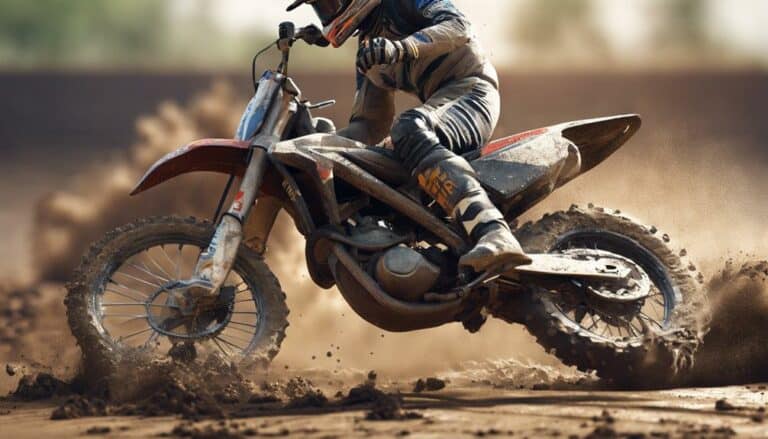When riding a dirt bike through a sandy track, you've likely experienced the challenge of braking effectively without losing control. But have you considered how different surfaces can impact your braking techniques beyond just sand?
From gravel to mud and hard-packed dirt, each terrain presents unique challenges that can influence your ability to stop safely and swiftly. Understanding these surface-specific nuances is key to mastering dirt bike braking methods and enhancing your overall riding experience.
Key Takeaways
- Mud and wet surfaces reduce brake pad traction, requiring increased pressure for effective braking.
- Sand surfaces decrease overall braking traction, necessitating smoother brake application and rear brake usage for stability.
- Rocky terrain demands rear brake utilization, standing while braking for control, and line selection to maintain traction.
- Hard packed dirt offers superior traction, utilizing front brake lever with controlled, less aggressive braking for stability.
Impact of Mud on Braking Techniques
When traveling through muddy terrain on a dirt bike, the impact of mud on braking techniques is significant. Mud reduces brake pad traction on rotors, necessitating increased pressure for effective braking in wet conditions.
Mud buildup between brake pads and rotors can lead to inconsistent braking performance and decreased stopping power. Brake modulation becomes challenging in muddy terrain due to the reduced friction between brake components.
So, smooth application of brakes is important to prevent wheel lock-up and maintain control. Additionally, mud accumulation on brake rotors can cause overheating and accelerated wear of brake pads, ultimately affecting braking efficiency.
To counter these effects, precise control and adjustment of braking pressure are essential to maximize stopping power while riding through muddy environments. Maintaining awareness of these challenges and adapting your braking techniques accordingly will help you navigate muddy terrain safely and effectively.
Braking Challenges on Sand
Traversing sandy terrain poses unique challenges for dirt bike riders when it comes to braking techniques due to the reduced overall braking traction and the shifting nature of sand surfaces. Sand surfaces decrease braking traction compared to harder terrains, leading to longer braking distances. To navigate these challenges effectively, riders must adopt a smoother and more gradual application of brakes to prevent wheel lock-up.
Due to the increased stopping distances on sand, it's essential to anticipate these factors and adjust braking accordingly. Techniques such as feathering the brakes, which involves lightly and rapidly applying them, can help maintain control on sandy surfaces. Additionally, utilizing more rear brake can assist in managing the bike's stability on these unpredictable surfaces.
Braking Strategies for Rocky Terrain
Traversing rocky terrain on a dirt bike demands a strategic approach to braking to confirm stability and control over the rugged landscape. When tackling rocky terrain, utilizing the rear brake primarily is vital to maintaining bike stability and preventing the suspension from becoming unsettled. Standing up while braking on rocky downhills enhances visibility, allows for better absorption of bumps, and improves overall control. It is essential to brake before reaching loose rocks to smoothly coast over them and avoid wheel lock-up. Selecting a smoother line to maneuver around loose rocks aids in sustaining traction during braking maneuvers. Pre-planning your attack line is key to anticipating obstacles on rocky terrain, reducing the likelihood of crashes.
| Braking Strategy | Description | Importance |
|---|---|---|
| Rear Brake | Maintain stability and prevent suspension issues by using the rear brake primarily. | High |
| Standing Position | Enhance visibility, absorb bumps, and ensure control by standing while braking downhill. | Moderate |
| Braking Before Obstacles | Prevent wheel lock-up and maintain smooth navigation by braking before hitting obstacles. | High |
| Choosing Smooth Lines | Ensure traction during braking maneuvers by selecting smoother paths around loose rocks. | Moderate |
Braking Considerations on Wet Surfaces
Consider the impact of wet surfaces on dirt bike braking, necessitating adjustments to brake application for traction and control. When riding on wet surfaces, keep in mind the following:
- Lighter Brake Application: Due to reduced tire traction on wet surfaces, applying the brakes more gently helps prevent skidding and loss of control.
- Increased Stopping Distances: Expect longer stopping distances on wet surfaces as the friction between tires and the ground decreases, requiring you to start braking early to compensate.
- Cautious Braking: Water on the surface can affect brake pad performance and response time. To mitigate the risk of hydroplaning and maintain control, practice cautious and gradual braking techniques.
Braking Differences on Hard Packed Dirt
Traversing hard packed dirt surfaces demands a nuanced approach to braking technique for best control and traction. On hard packed dirt, the surface offers superior traction compared to loose terrain, enabling riders to rely more on the front brake lever for effective braking forces.
However, caution must be exercised to prevent locking up the wheels, requiring a less aggressive application of the brakes. To execute controlled braking on hard packed dirt, it's essential to optimize weight distribution and body positioning. This guarantees that the tires maintain grip with the ground, allowing for quicker deceleration while maintaining stability.
Conclusion
To sum up, adjusting your dirt bike braking techniques based on the surface you're riding on is vital for maintaining control and safety.
Just like a skilled dancer adapts their movements to different music beats, a rider must adapt their braking to the varying levels of traction and grip.
By mastering these adjustments, you can effectively navigate through mud, sand, rocks, and other terrains with confidence and skill.

